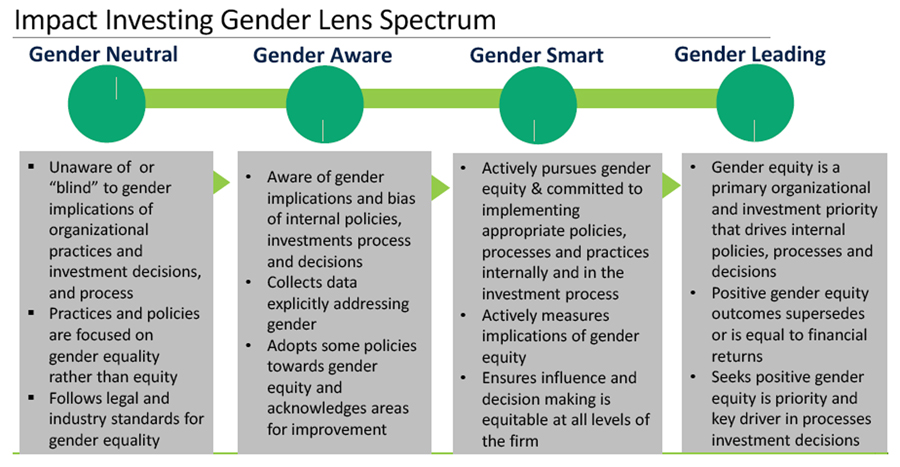By Athena Global
Download a PDF version of the following Tip Sheet:
Gender Lens Investing (GLI) is the intentional act of making investment decisions and adopting processes and policies that will have a positive effect on women, girls, or gender equity.
No one right way to do GLI. Although it would be convenient to have a checklist of what it takes to be “GLI compliant,” it is a much more nuanced art that varies among organizations, investment products, transactions and reporting frameworks. One important consideration, however, is the “intentionality,” meaning that there is an active consideration for making investment decisions that have a positive effect on women, girls or gender equity.
A spectrum of approaches. There are myriad approaches to GLI, with more firms developing or adopting approaches every day. It’s important that an organization has a clear view on where they are on the spectrum (or where they’d like to be!), and understands why that makes sense for the organization, investors and stakeholders.

No single definition for GLI. Some organizations take the view that all investing has a gender angle; others develop an investment thesis that defines GLI as investing in a woman-owned or woman-led business. Most definitions fall in the middle and can also include specific language about including women in management, women on boards, women employees, or having a positive impact on women, girls or gender equity. Functionally, a GLI definition and investment thesis should include things easy to identify (i.e. the number of women in management) while also ensuring a long-term benefit to ensure that the inclusion of women or gender equity doesn’t become token representation without changing the fundamental influence and decision-making authority of women and men.
Internal alignment. GLI goes beyond adopting an investment process devoid of discrimination or bias that is used for screening opportunities. In order to ensure the principles driving GLI permeate the investment industry, an organization must also “turn the mirror” inward to ensure that organizational policies, procedures, practices and culture are gender equitable. This can include making sure that women are represented on the management team, in meaningful investment and business decisions, and across all functions and levels of an organization. Formally, policies and processes should also clearly outline gender-equitable practices. Finally, the culture and tone of the organization must also reflect a legitimate environment that promotes gender equity in practice, and not only on paper.
Investment Process. Identifying and neutralizing gender bias in the investment process is key to GLI. This includes removing outright discrimination and also addressing conscious and unconscious bias. Often, identifying bias or discrimination is the easy part; the real work is in developing processes and policies that offer a gender equitable alternative.

The investment lifecycle presented here is bookended by two critical, but often overlooked areas of GLI: network and portfolio monitoring. On the front end, the network is a critical component to effective GLI—since it is the first part of the funnel for the investment process, if women aren’t equitably represented in this phase, then they will be similarly under- or unrepresented throughout the entire process. On the back end, without effective monitoring of the portfolio performance with and without GLI (with whatever definition and impact thesis adopted by an organization), it’s impossible to go beyond counting women and move toward valuing women and gender equity both quantifiably in the portfolio performance, and qualitatively, in terms of changing cultural norms, empowerment and social benefits.
It’s not only about women and girls. Although it’s easy to assume that GLI is only about women and girls, fundamental to the approach is the word “gender.” The aim of GLI is to bring about gender equity, based on cultural and social norms pertaining to the roles of women (and girls) and men (and boys), and the value associated with those roles. In many cases, women and girls are excluded from or under-represented in certain roles or have social expectations because of gender; GLI aims to acknowledge and rectify this inequity to ensure that all roles and genders are accepted, encouraged and valued equally. As an example of how this affects men, organizations that have equitable maternity and paternity leave policies for both men and women acknowledge and encourage men and women to take an active and equal role in childrearing during the early months of a child’s life, by ensuring that both parents (of any gender) can choose to take the same amounts of time away from work to actively participate in parenting.
For more information, contact Kaylene Alvarez at [email protected]



0 Comments